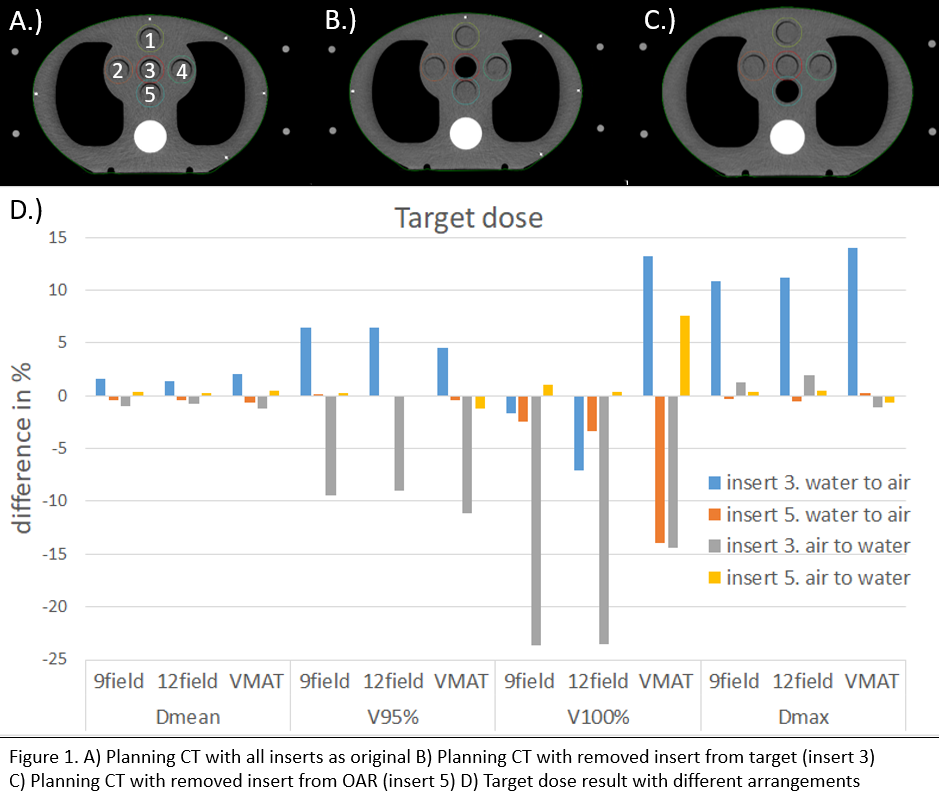Effect of tissue density variation on adaptive radiation treatment planning
Domonkos Szegedi,
Hungary
PO-1931
Abstract
Effect of tissue density variation on adaptive radiation treatment planning
Authors: Domonkos Szegedi1, Ádám Gáldi1, Tibor Major1,2, Csilla Pesznyák1,3
1National Institute of Oncology, Radiotherapy Center, Budapest, Hungary; 2Semmelweis University, Department of Oncology, Budapest, Hungary; 3Budapest University of Technology and Economics, The Institute of Nuclear Techniques, Budapest, Hungary
Show Affiliations
Hide Affiliations
Purpose or Objective
Ethos online adaptation uses deformed planning CT based on acquired CBCT image to calculate the dose of the online adapted treatment plan. Thus, non-deformation based changes in anatomy such as body cavities filled with material of different density daily can cause differences in calculated and delivered dose. Our aim was to investigate the effect of appearance or disappearance of gas in body lumens on dose calculation using Ethos Treatment Planning 1.1 system (dose to medium).
Material and Methods
Cirs Thorax IMRT phantom was scanned with a Siemens Somatom Go.Sim CT for planning purposes. 5 cm length of central inserts with a uniform extension of 5 mm were used as target structure (insert 3) and organs at risk in the proximity of the target (insert 1,2,4,5)(Figure 1.). Scanning the phantom with removed insert simulated the appearance of air either in the target or in a nearby healthy organ (insert 5). Treatment plans were generated with 9-field, 12-field IMRT and 2-Arc VMAT. The same optimization goals were used for each arrangement, and the original plans were recalculated on the CT images using inserts with different filling to examine the change of target coverage (V95% and V100%), dose maximum, mean dose and OAR doses (V50% and mean dose). We delivered these plans replacing only a single insert during online adaptation. Ethos used a simulation CT for dose calculation with or without air as on the original planning CT and not with removed or added air seen on CBCT. Thus, we could consider the difference in doses calculated on CT with or without air filling as the difference of calculated and delivered dose for the adapted fraction in this theoretical set-up.

Results
In target V95% coverage we obtained the largest differences when the insert in target was changed. Replacing air with water density resulted in an increase of 5,8±1,1% while substituting the water insert with air decreased the coverage by 9,8±1,1%. Variation is due to the different techniques. The presence or absence of OAR gas did not affect the target V95% more than 0,5 %. The same trends were obtained for target Dmean (Figure 1.). V100% of the target (PTV) showed the largest difference when insert was changed from water to air in the target (-20,5±5,3%), and change in OAR insert for VMAT also resulted in a large decrease for target coverage (-14%). Mean dose to nearby OAR inserts changed less than 2% for any set-up except for insert 5 when the insert was removed. The difference increased to more than 10% when original optimisation aimed to lower the mean dose to this volume.
Conclusion
Online adaptation on Ethos cannot take into account appearance or disappearance of air in body cavities as a non-deformation based change in anatomy. Target coverage and mean dose are most likely to deteriorate when air appears in the target while maximum dose increases the most where air is disappearing in the target. The dose to nearby OARs is less sensitive for changes in gas filling at or near the target.